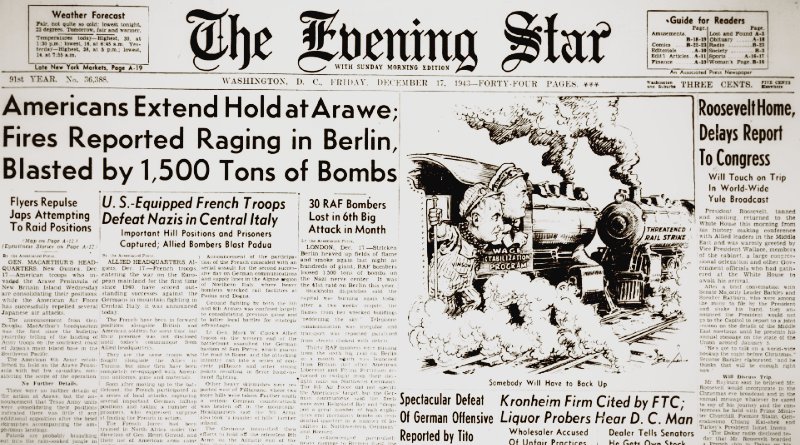World War II Chronicle: December 17, 1943
Click here for TODAY’S NEWSPAPER
George Fielding Eliot discusses the New Britain landing on page 10… Sports begins on page 16
Roving Reporter by Ernie Pyle
AT THE FRONT LINES IN ITALY, Dec. 17 — Artillery batteries are “laid in,” as artillerymen say, in all kinds of positions, but my “Battery E” is probably typical.
Our four guns are set in and around a grape arbor. On one side a ridge rises steeply 400 or 500 feet. A broad valley spreads out below us. It is very pretty where we are.
The four guns form a rough square about the size of a city block, and they are so close under the brow of a hill that it’s almost impossible for the German artillery to reach us. Each gun is planted in a pit about three feet deep, and the front of the pit is lined, shoulder high, with sandbags.
Over the entire pit is stretched a camouflage net on poles. The net, just head high, gives you the sense of having a roof over you. When the guns are quiet you can yell from one gunpit to another.
A few feet on one side of the gun pit is a stack of black cases about three feet long, clipped together in triple clusters. These are the powder charges.
On the other side of the pit lies a double row of rust-colored shells. The ammunition carriers keep a supply of 10 or 12 shells inside the pit, but the powder charges are brought in one at a time, just before the shooting, because of the danger of fire.
The floor of the gunpit is muddy and you have to move carefully to stay on your feet. One day one of the ammunition carriers, a slight fellow, slipped with his heavy shell and let out an irritated oath. Whereupon the sergeant said sarcastically, “Hush. The devil will get you for talking like that.”
Several times a day an ammunition truck comes plowing through the muddy field, backs up to the gun pit and unloads another truckload of shells. It’s a game with the gun crew to try to get the truckers to carry the shells inside the pit instead of stacking them outside, and sometimes, when in good humor, they’ll do it.
All four guns are connected to the battery’s executive post by telephone, and the chief of each crew wears a headphone all the time he’s in the pit. An executive post may be anything from a telephone lying on the ground under a tree, clear up to the luxury of an abandoned cowshed. But it is always within a few yards of the battery.
An officer in the executive post gives the firing directions to the four guns in his battery. He gets his instructions from the regimental command post half a mile or so to the rear, which in turn receives its firing orders from the division command post and from its own observation towers far ahead in the mountains.
The men of a gun crew live in pup tents a few feet from the gun pit. Since an artillery unit usually stays in one place for several days, the men have time to pitch their tents securely and dig little irrigation ditches around them.
They cover the floors of the tents with straw and make themselves dry inside the tents, at least. For each two gun crews there is also a larger pyramidical tent, empty except for the straw on the ground. Nobody lives in here but the ground crews use it for a loafing place in the daytime when they aren’t firing, and for playing poker at night by candle light. They just sit or lie on the ground while they play, since there is no furniture.
There is a kitchen truck for each battery. Our truck is full of battle scars. There are holes in the walls and roof from bomb fragments, and the stove itself has a huge gash in it, yet nobody in the kitchen has ever been hurt.
The battery’s three officers eat standing up at a bench inside the truck while the men eat outside, either sitting on their steel helmets in the mud or standing up with their mess kits resting on a farmer’s stone wall. They don’t all eat at once. Three go at a time from each crew, since the guns are never left, day or night, without enough men to fire them.
Our crew claims it can fire faster with three men than the others can with 10, but of course all crews say that. The crews don’t actually stay at the alert inside the gun pit all the time. But they are always close enough to get there in a few seconds when the whistle blows.
Supper is at 4:30, and by 5:30 it is dark. There is nothing to do, no place to go, and even inside the big tents the candle light isn’t conducive to much fun, so usually the crews are asleep by 8:30. Some take off their pants, but most of them just remove their shoes and leggins. Each crew posts a guard, which is changed every two hours throughout the night, to stand by the field telephone and listen for firing orders.
Most of the cannoneers have got so they can sleep through anything. Steady firing, even fairly close, doesn’t keep you awake after you’re used to it. It’s the lone battery that suddenly whams away after hours of complete silence that brings you awake practically jumping out of your skin.
Evening star. (Washington, D.C.), 17 December 1943. Chronicling America: Historic American Newspapers. Lib. of Congress.
https://chroniclingamerica.loc.gov/lccn/sn83045462/1943-12-17/ed-1/
